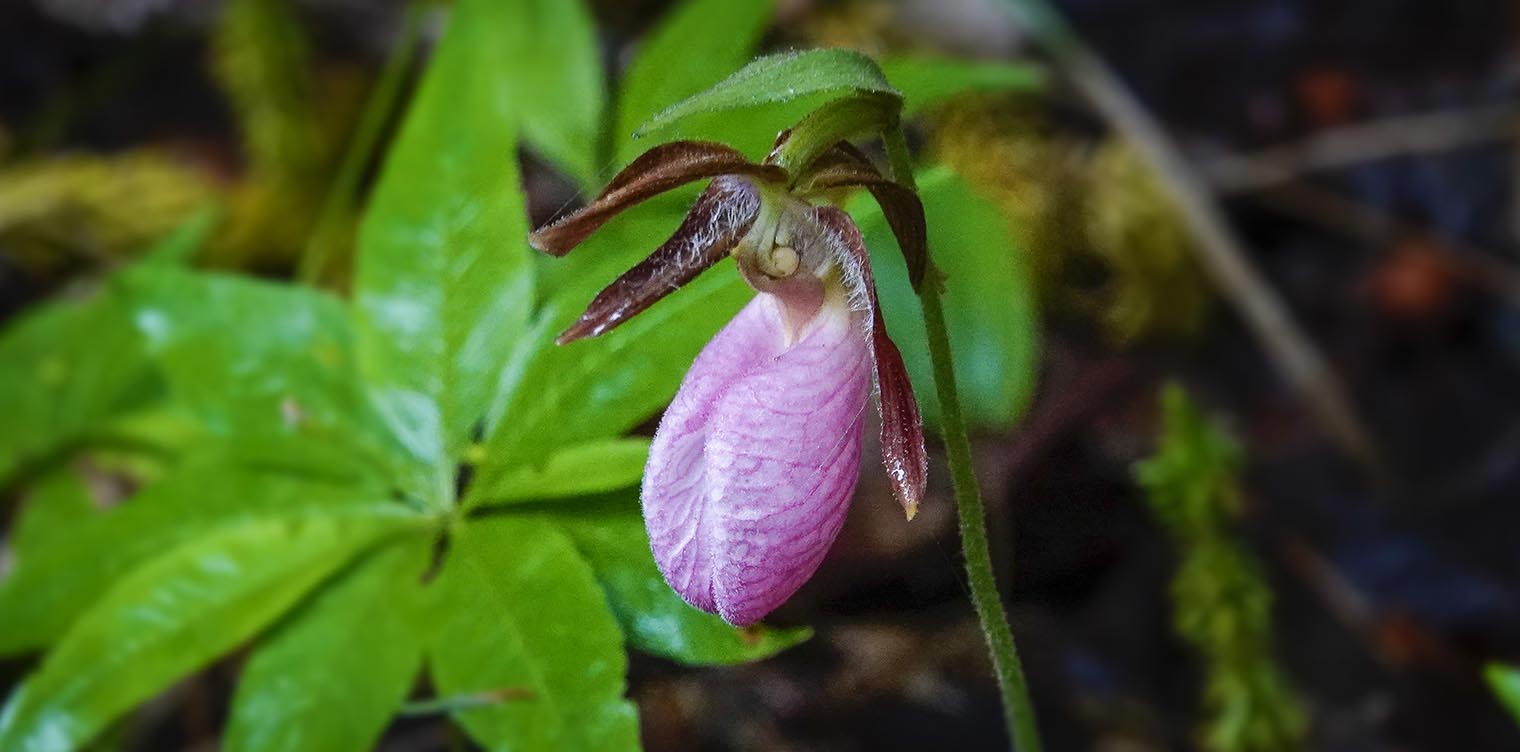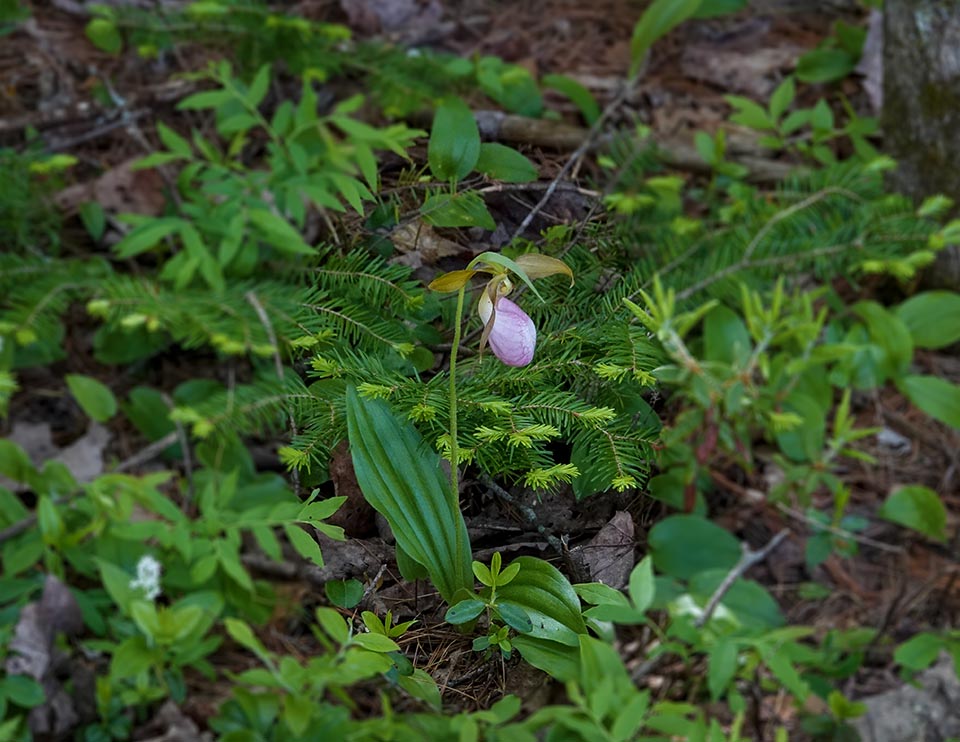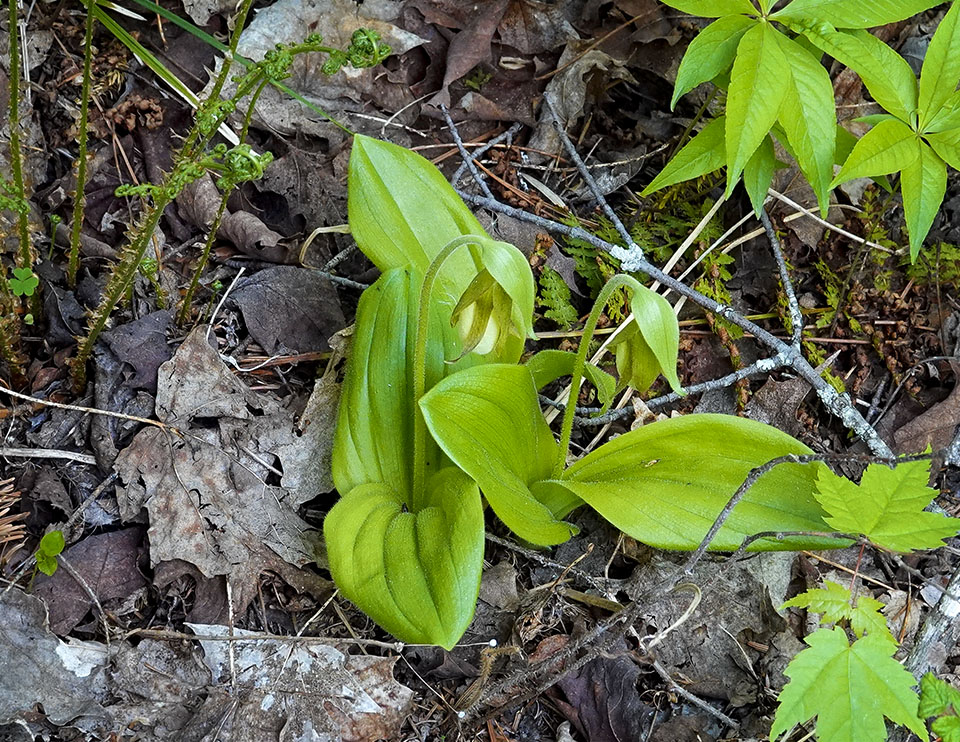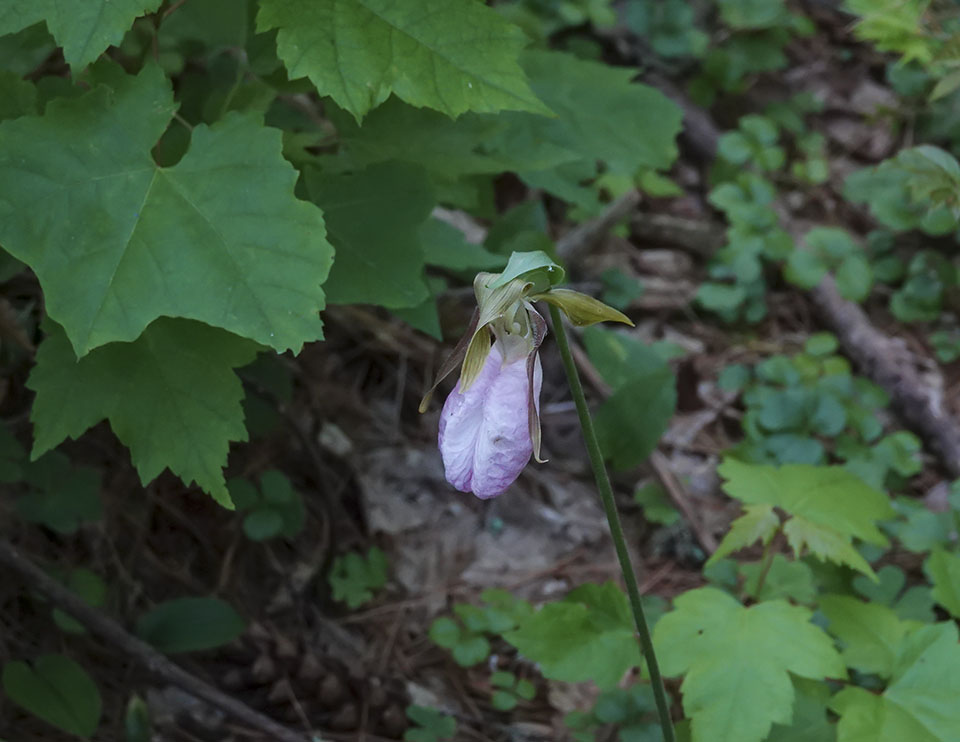Wildflowers of the Adirondacks:
Pink Lady's Slipper (Cypripedium acaule Aiton)

Pink Lady's Slipper (Cypripedium acaule Aiton) is a large, showy wildflower belonging to the orchid family. It blooms in the Adirondacks from late May to late June. The genus name (Cypripedium) is from the Greek "Kypris" (Venus) and "pedilon," meaning slipper. The species name (acaule) is Latin, meaning, "stem less," referring to the fact that the leaves of the plant appear to arise from the root and not from the plant stem.
Other common names include Moccasin Flower, Pink Moccasin Flower, Stemless Lady’s Slipper, Squirrel Shoes, Small Pink Lady’s-slipper, Stemless Lady’s-slipper, Lady's-slipper Orchid, Pink Lady's-slipper Orchid and American Valerian. The latter name is a reference to the fact that this plant was once widely used as a substitute for the European plant valerian for its sedative properties.
Identification of Pink Lady's Slipper

Pink Lady's Slipper is an upright plant ranging from six to twelve or fifteen inches tall. This plant is often seen growing in groups. The stems are covered with fine hairs.
Each plant has a pair of basal leaves, meaning that the leaves grow from the lowest part of the stem. The leaves are one to three inches wide and up to eight inches long, oblong, with a pointed tip. The leaves are smooth (not toothed), usually a rich green above and silvery and hairy below. They have a prominent central vein, similar to those of Clintonia (Blue Bead Lily). However, in contrast to Clintonia leaves, the leaves of the Pink Lady's Slipper are deeply pleated, with prominent parallel veins in addition to the central vein.
Pink Lady's Slipper flowers bloom at the top of a leafless stalk. The flowers have a distinctive, slipper-like lip about two inches long. The lip is pink, ranging in color from very light pink to deep rose, with darker red or violet veins. The lip is cleft along the middle and flanked by a pair of tapering, narrow twisted petals that are yellowish green to purple with fine hairs.

In the Adirondack Park, Pink Lady's Slippers usually bloom from the fourth week in May to about the third week in June. A tally of flowering dates for the upland Adirondack areas compiled by Michael Kudish, based on data collected from the early seventies to the early nineties, lists the earliest flower date as 30 May and the median date as 13 June. A review of iNaturalist observations suggests a somewhat earlier bloom date in some parts of the Adirondack Park.
Pink Lady's Slippers are pollinated by bees that enter the flower through the slit in the front of the pouch. The insects can escape only through exits beneath each pollen mass. When the bee passes under the stigma, it deposits pollen from previous visits to other flowers and picks up a fresh load of pollen.
The fruit of the Pink Lady's Slipper is a capsule that ripens from green to tan or brown and contains thousands of tiny seeds. When the capsule splits, the powdery seeds are dispersed by the wind. The seed must find be joined by a mycorrhizal fungus before it can absorb soil nutrition.
Uses of Pink Lady's Slipper
No edible uses of this species were found. Pink Lady's Slippers were once used as a remedy for a variety of ailments, including nervousness, sleeplessness, kidney disorders, and muscle spasms. Native American peoples used an infusion of the roots for colds, clue, and urinary tract disorders.
This plant propagates very poorly and should not be picked. Like all orchid species in New York State, Pink Lady's Slippers are on the state protected list. It is a violation for anyone to remove or damage an orchid that is on state land. Removal of an orchid from private land is prohibited without the landowner's consent.
In any event, it's best to avoid contact with Pink Lady's Slippers, since plants of the genus Cypripedium have glandular hairs on the leaves and stems that can cause a rash, similar to poison ivy rash, upon contact.
Wildlife Value of Pink Lady's Slipper

No wildlife uses of this species were found.
Distribution of Pink Lady's Slipper
Pink Lady's Slippers are found from Saskatchewan to Newfoundland and Nova Scotia; south to South Carolina and Georgia; west to Alabama and Tennessee; and north to Minnesota. This plant is listed as endangered in Illinois and Tennessee and unusual in Georgia
This plant is found in almost all counties in New York State, where it is listed as exploitably vulnerable. Pink Lady's Slipper is found in all counties within the Adirondack Park Blue Line.
Habitat of Pink Lady's Slipper
Pink Lady's Slipper grows in a variety of habitats. In the Adirondack Mountains, this plant can be found growing on well-drained sites, often under partial shade in conifer forests. Pink Lady's Slipper also grows under hardwoods and in Mixed Wood Forests. It is typically found in acidic soils. It can also be seen on the edges of swamps and bogs.
References
Michael Kudish. Adirondack Upland Flora: An Ecological Perspective (The Chauncy Press, 1992), pp. 26, 234.
New York Flora Association. New York Flora Atlas. Pink Lady's-slipper. Cypripedium acaule Aiton. Retrieved 24 May 2022.
United States Department of Agriculture. The Plants Database. Moccasin Flower. Cypripedium acaule Aiton. Retrieved 24 May 2022.
United States Department of Agriculture. Forest Service. Plant of the Week. Pink Lady's Slipper (Cypripedium acaule Ait.). Retrieved 24 May 2022.
Flora of North America. Cypripedium acaule Aiton. Retrieved 27 May 2017.
NatureServe Explorer. Online Encyclopedia of Life. Pink Lady's-slipper. Cypripedium acaule - Ait. Retrieved 24 May 2022.
Native Plant Trust. Go Botany. Pink Lady's-slipper. Cypripedium acaule Ait. Retrieved 24 May 2022.
New York State. Department of Environmental Conservation. New York Natural Heritage Program. Ecological Communities of New York State. Second Edition (March 2014), pp. 101-102. Retrieved 17 October 2015.
New York Natural Heritage Program. 2022. Online Conservation Guide for Pitch Pine-Heath Barrens. Retrieved 24 May 2022.
New York State. Adirondack Park Agency. Preliminary List of Species Native Within the Adirondack Park Listed Alphabetically by Scientific Name and Sorted by Habit. Volume 1. Updated 10.23.2006, p. 19. Retrieved 26 January 2017.
USA National Phenology Network. Nature’s Notebook. Cypripedium acaule. Retrieved 27 May 2017.
iNaturalist. Adirondack Park Observations. Pink Lady's Slipper. Cypripedium acaule. Retrieved 24 May 2022.
Connecticut Botanical Society. Pink Lady's-slipper (Pink Moccasin-flower). Retrieved 24 May 2022.
University of Wisconsin. Flora of Wisconsin. Cypripedium acaule Aiton. Retrieved 24 May 2022.
Minnesota Wildflowers. Cypripedium acaule (Stemless Lady's-slipper). Retrieved 27 May 2017.
Lady Bird Johnson Wildflower Center. Cypripedium acaule. Retrieved 24 May 2022.
Anne McGrath. Wildflowers of the Adirondacks (EarthWords, 2000), p. 27, Plate 13. Retrieved 24 May 2022.
Roger Tory Peterson and Margaret McKenny. A Field Guide to Wildflowers. Northeastern and North-central North America (Houghton Mifflin Company, 1968), pp. 14-15, 212-213. Retrieved 24 May 2022.
Doug Ladd. North Woods Wildflowers (Falcon Publishing, 2001), p. 88.
Lawrence Newcomb. Newcomb's Wildflower Guide (Little Brown and Company, 1977), pp. 22-23.
Ruth Schottman. Trailside Notes. A Naturalist's Companion to Adirondack Plants (Adirondack Mountain Club, 1998), pp. 73-76.
National Audubon Society. Field Guide to North American Wildflowers. Eastern Region. (Alfred A. Knopf, 2001), pp. 469, 653-654.
William K. Chapman et al. Wildflowers of New York in Color (Syracuse University Press, 1998), pp. 64-65.
Gary Wade et al. Vascular Plant Species of the Forest Ecology Research and Demonstration Area, Paul Smiths, New York. USDA Forest Service. Research Note NE-380, p. 4. Retrieved 22 January 2017.
Mark J. Twery, at al. Changes in Abundance of Vascular Plants under Varying Silvicultural Systems at the Forest Ecosystem Research and Demonstration Area, Paul Smiths, New York. USDA Forest Service. Research Note NRS-169. Retrieved 22 January 2017, p. 7.
William K. Chapman. Orchids of the Northeast. A Field Guide (Syracuse University Press, 1997), pp. 20-21.
Paul Martin Brown. Wild Orchids of the Northeastern United States. A Field Guide (Cornell University Press, 1997), pp. 62-63.
John Eastman. The Book of Forest and Thicket: Trees, Shrubs, and Wildflowers of Eastern North America (Stackpole Books, 1992), pp. 117-119.
Plants for a Future. Cypripedium acaule - Aiton. Retrieved 24 May 2022.
Steven Foster and James A. Duke. Medicinal Plants and Herbs of Eastern and Central North America (Houghton Mifflin Harcourt, 2014), p. 156.
University of Michigan. Native American Ethnobotany. A Database of Foods, Drugs, Dyes and Fibers of Native American Peoples, Derived from Plants. Cypripedium acaule Ait. Retrieved 24 May 2022.
Allen J. Coombes. Dictionary of Plant Names (Timber Press, 1994), p. 55. Retrieved 24 May 2022.
Charles H. Peck. Plants of North Elba (Bulletin of the New York State Museum, Volume 6, Number 28, June 1899), p. 131. Retrieved 24 May 2022.
